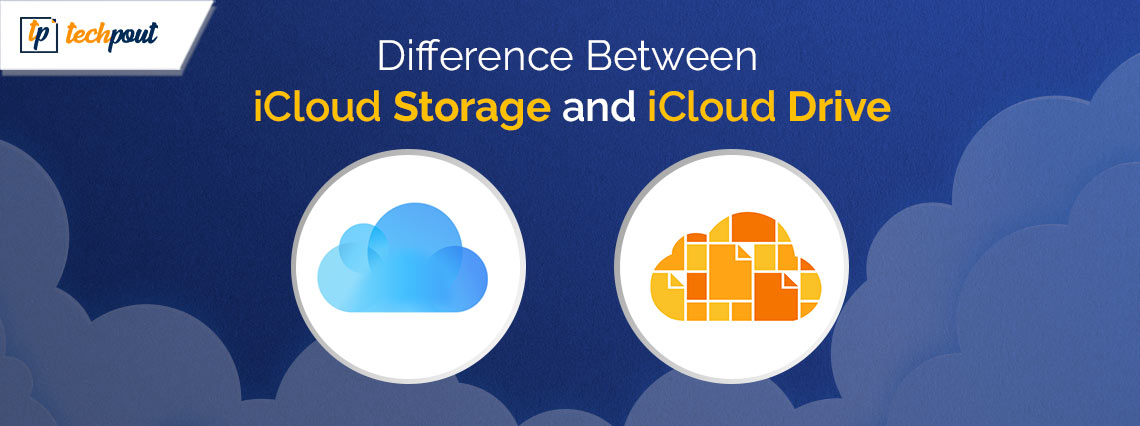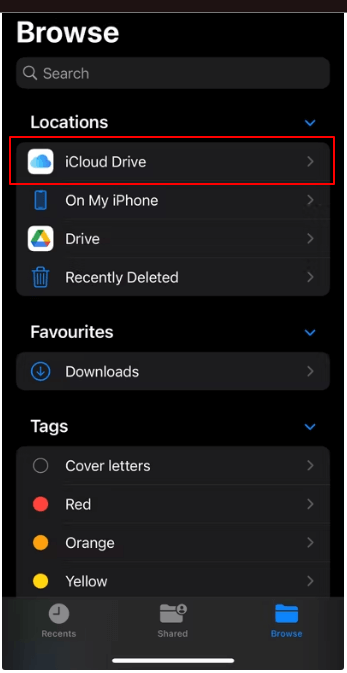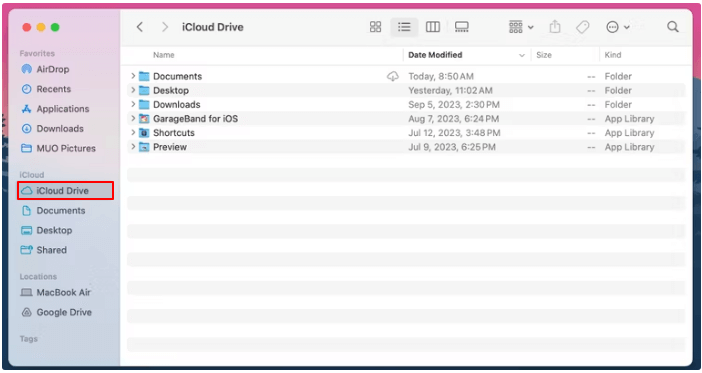Difference Between iCloud and iCloud Drive

This article describes iCloud Storage and Drive, their differences, and everything you need to know about them in detail.
Apple understands the storage requirements of users. That is why it offers two options, one iCloud Drive and the other iCloud, to store your documents, photos, contacts, videos, and more. However, whether they are the same or different and what makes them differ is perplexing.
Let us clear the air about this through our article. To understand how they are different, first, you need to understand them in individuality. Hence, let us begin by gaining a deeper insight into these storage solutions before comparing them.
What are iCloud Storage and iCloud Drive
In the following paragraphs, we are going to elaborate on iCloud and iCloud Drive, beginning with iCloud.
iCloud
Apple iCloud Storage is a cloud solution that allows you to store and back up your data, such as photos, documents, contacts, etc. It helps you free up space on your iPhone (which is already limited to only a few GBs). Moreover, it has the following advantages and a few disadvantages.
Pros and cons of iCloud
Pros
- Easy sharing, storage, and synchronization of files across different platforms and devices
- iCloud facilitates collaboration with others
- You can use iCloud to find misplaced devices, share web activity and passwords, and synchronize constantly changing information
Cons
- You need an Apple ID to view files on iCloud
- It lets you share files with only other Apple users
- The search function is slow and inefficient, making file management difficult
After considering the pros and cons of iCloud Storage, if you wish to try it, you can follow the steps in the below section.
How to access iCloud Storage
- First, navigate to your Apple device’s Settings.
- Next, select your name and then choose iCloud.
We hope you are now familiar with iCloud Storage. Let us now learn more about iCloud Drive.
Also know: How to Recover Deleted Files from iCloud
iCloud Drive
Apple is the parent of iCloud Storage and iCloud Drive, both being siblings with similar characteristics. What we mean is iCloud Drive is very similar to iCloud Storage in features. For example, like iCloud Storage, it lets you sync and store data across various Apple devices. However, it is slightly different from iCloud Storage in its file organization and management.
iCloud Drive pays more attention to file organization. The features of iCloud when it comes to organizing files offer greater customization and flexibility. For instance, it allows you to add tags to categorize files and keep files in folders and subfolders to find them effortlessly whenever required.
However, more emphasis on file organization and management is one of many distinguishing factors between iCloud Drive and iCloud Storage. They are different from one another in a lot of ways (more on that in the later part of this article). First, let us concentrate on the advantages and disadvantages of iCloud Drive and how to access it for better understanding.
Pros and cons of iCloud Drive
Pros
- It boasts an affordable pricing structure
- iCloud Drive offers seamless integration with all Apple devices
- The interface of iCloud Drive is intuitive and friendly
Cons
- It is not suitable for those without Apple devices
- iCloud Drive has significant privacy and security concerns
After looking at the hits and misses of iCloud Drive, here is how to access it if you wish.
How to access iCloud Drive
On iPhone/iPad
- First, navigate to Files on your iPad or iPhone.
- Next, choose Browse from the lower section of the File window.
- A list of Locations will appear on your screen. You can choose Cloud Drive to access your files in the iCloud Drive.

On Mac
- First, launch Finder on your Mac.
- Next, choose iCloud Drive from the left section of the on-screen window.

Note: If you do not see the iCloud Drive option in the Finder, you can access it by following the path Finder>Settings>Sidebar tab>iCloud Drive.
On Windows PC
- First, launch File Explorer on your computer.
- You can now access iCloud Drive from the Quick Access menu on the left pane of the File Explorer window.
On Android
- First, open the web browser on your device.
- Next, navigate to iCloud.com and log in using your Apple ID.
- After logging in to iCloud, choose the Apps icon from the upper-right corner, alongside your profile picture.
- You can now tap Drive to view your iCloud Drive files.

That was all for iCloud Drive, its pros and cons, and how to access it. Now that you have a fair understanding of iCloud Storage and iCloud Drive, we can discuss their differences in the following section.
Also know: How to Download Photos from iCloud to iPhone, Mac, and Windows PC
Differences Between iCloud Storage and iCloud Drive
Comparing iCloud Drive and iCloud Storage reveals the following differences between the two.
Management of files
As explained in the previous paragraphs of this write-up, iCloud Storage is primarily concerned with file storage and automatic syncing. Its features are limited when it comes to the organization and management of files. Whereas, iCloud Drive, in addition to storage and synchronization, offers better file management and organization.
Compatibility with non-Apple devices
If cross-platform compatibility is what you are looking for, we advise you to use iCloud Drive. It boasts better compatibility with devices other than Apple.
Collaboration features
Though both iCloud Drive and iCloud boast collaboration features, collaborating with others is easier with iCloud Drive. You can allow others to view, comment, or edit your files with iCloud Drive in real time.
Backup and sync options
iCloud serves better when it comes to sync and backup features. You can use iCloud to sync your data across various Apple devices effortlessly. Moreover, it creates automatic device backups that come in handy when you switch devices or wish to recover lost data.
iCloud Drive, on the other hand, offers more file-centric sync options, letting you select which folders and files you want to sync across your devices.
Considering the iCloud and iCloud Drive’s features, pros and cons, and the above differences, we found iCloud Drive a slightly better choice for data storage, organization, management, and collaboration. However, since iCloud Drive is also limited to 5GB of free storage space, it is easy to run out of space. Hence, below are some effective tips on how to free up storage space in iCloud Drive if it gets full.
Tips to free up iCloud Drive space
You can clean the iCloud Drive by following these simple tips.
Delete the unneeded backups
The old backup files you may not need anymore may hog up the drive space. Hence, deleting these files can make room on the iCloud Drive for other crucial files and data.
Remove large videos and delete unrequired photos
Photos and videos often form a large part of the iCloud Drive for most of the users. However, some duplicate or unwanted photos/videos may lie in the iCloud Drive, eating up the space. Hence, you can find and remove them from the drive.
Turn off the automatic backup
Your Mac may automatically create data backups on iCloud Drive, taking up significant drive space. Hence, you can disable automatic backups to free up the space.
Remove/transfer large files
Files or folders that are significantly large may consume a lot of iCloud Drive space. Thus, you can remove them or transfer them to some other location.
Also know: How to Delete an iCloud Account
Summing Up
This article explained and compared iCloud Storage and iCloud Drive with each other to help you make the right choice for your requirements. It also touched upon how to free up the iCloud Drive space for efficient storage and management. Hopefully, you got all that you were looking for. However, please do not hesitate to drop a comment if you have any questions or concerns about this write-up.


